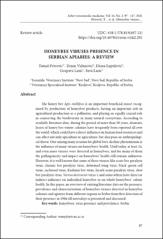Honeybee viruses presence in Serbian apiaries: a review

View/
Date
2021Author
Petrović, Tamaš
Vidanović, Dejan
Lupulović, Diana
Lazić, Gospava
Lazić, Sava
Metadata
Show full item recordAbstract
Th e honey bee Apis mellifera is an important benefi cial insect recognized by production of honeybee products, having an important role in
agricultural production as a pollinator, and playing an equally crucial role
in conserving the biodiversity in many natural ecosystems. According to
available literature data, during the period of more than 30 years, dramatic
losses of honey bee winter colonies have frequently been reported all over
the world, which could have a direct infl uence on human food resources and
can aff ect not only apiculture or agriculture, but also pose an anthropological threat. One among many reasons for global bees-decline phenomenon is
the infl uence of many viruses on honeybees’ health. Until today, at least 24,
and even more viruses were detected in honeybees, and for many of them
the pathogenicity and impact on honeybees’ health still remain unknown.
However, it is well known that some of these viruses like acute bee paralysis
virus, chronic bee paralysis virus, deformed wing virus, black queen cell
virus, sacbrood virus, Kashmir bee virus, Israeli acute paralysis virus, slow
bee paralysis virus, Varroa destructor virus-1 and some others have direct or
indirect infl uence on individual honeybee or on whole honeybees’ colony
health. In this paper, an overview of existing literature data on the presence,
prevalence and characterization of honeybee viruses detected in honeybee
colonies and apiaries from diff erent regions in Serbia from fi rst detection of
their presence in 1986 till nowadays is presented and discussed.
